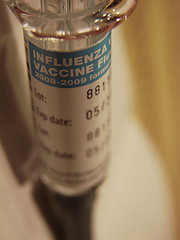 We are in the midst of a really nasty flu season. You don’t want to catch this flu, and you won’t want your family members to catch it, either. Your risk of being exposed to the flu relates, in many ways, to health insurance coverage. This includes both your coverage and the coverage of the people you work with.
We are in the midst of a really nasty flu season. You don’t want to catch this flu, and you won’t want your family members to catch it, either. Your risk of being exposed to the flu relates, in many ways, to health insurance coverage. This includes both your coverage and the coverage of the people you work with.
The Center for Disease Control and Prevention (CDC) recommends that everyone who is age 6 months or older get a flu shot. Getting an immunization for influenza is one way to help prevent yourself (or your family member) from catching the flu
As of September 23, 2010, all health insurance plans are required to cover the cost of an immunization for influenza (also called a “flu shot”). It is part of preventative care. They must cover it without charging the consumer for a co-pay, co-insurance, or deductible. You might want to make sure that you get your flu shot from a health care provider that your insurer considers to be within your network, just in case.
People who do not have health insurance coverage aren’t going to be able to get this immunization “for free”. (It’s not truly free – you are paying premiums, after all). Often, this means that people who lack health insurance coverage do not go and get a flu shot. They are now at a higher risk of catching the flu than they might have been if they got the influenza immunization.
Many businesses, both large and small, offer full-time workers an employer sponsored health plan. Part-time workers are (usually) not eligible for that coverage. This means that every work place has some people who have access to health care (and a flu shot), and other workers who don’t have that access. This group is more at risk for catching the flu than the insured group is.
There’s another way that health insurance coverage (or lack thereof) relates to the flu. Part-time workers typically receive very low wages. It can be very expensive to see a doctor and to pay for the medications that a doctor prescribes if you don’t have health insurance to help with the cost.
Many workplaces require an employee to produce a doctor’s note to prove that they really were sick on the day they stayed home. If you cannot afford to see a doctor, then you cannot get a doctor’s note. The result is that a lot of people come to work when they are too sick to be there (and potentially contagious). This is how the flu gets spread around.
Workers who do have access to a health plan, but who don’t get paid sick days, also come into work while they are sick. In short, even if you are lucky enough to have health insurance coverage, you are still being exposed to illnesses from sick co-workers who can’t afford to take a sick day and see a doctor.
If everyone had health insurance coverage, then everyone would be able to get a flu shot. If all workers got paid sick days, then it would enable a sick employee to stay home when he or she has the flu. This would help prevent a “flu bug” from spreading.
Image by Samantha Celera on Flickr

